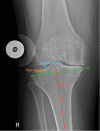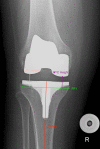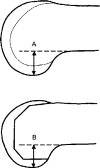Improved joint line and posterior offset restoration in primary total knee replacement using a robotic-assisted surgical technique: An international multi-centre retrospective analysis of matched cohorts
- PMID: 36006969
- PMCID: PMC9409519
- DOI: 10.1371/journal.pone.0272722
Improved joint line and posterior offset restoration in primary total knee replacement using a robotic-assisted surgical technique: An international multi-centre retrospective analysis of matched cohorts
Abstract
Background: Accurate restoration of joint line height and posterior offset in primary Total Knee Arthroplasty (TKA) have been shown to be important factors in post-operative range of movement and function. The aim of this study was to assess the accuracy of joint line and posterior offset restoration in a group of patients that underwent robotic-assisted TKA (raTKA). A matched cohort of patients that underwent a TKA using a conventional jig-based technique was assessed for comparison. The null hypothesis was that there would be no difference between groups.
Methods: This study was a retrospective analysis of a cohort of 120 patients with end-stage knee osteoarthritis that received a TKA using the Navio Surgical System (n = 60), or Conventional manual TKA (n = 60). Procedures were performed between 1 January 2019 and 1 October 2019 at six different centres. Joint line height and posterior offset was measured pre-operatively and post-operatively on calibrated weight bearing plain radiographs of the knee. Two observers performed measurements using validated measuring tools. A BMI and age-matched cohort of patients that underwent TKA using a conventional technique in the same six centres were assessed for comparison. Mean values, standard deviations and confidence intervals are presented for change and absolute change in joint line height and posterior offset. Student's t-test was used to compare the changes between techniques.
Results: Patients that underwent robotic-assisted TKA had joint line height and posterior offset restored more accurately than patients undergoing TKA using a conventional technique. Average change from pre-operative measurement in joint line height using raTKA was -0.38mm [95% CI: -0.79 to 0.03] vs 0.91 [0.14 to 1.68] with the conventional technique. Average absolute change in joint line height using raTKA was 1.96mm [1.74 to 2.18] vs 4.00mm [3.68 to 4.32] with the conventional technique. Average change in posterior offset using raTKA was 0.08mm [-0.40 to 0.56] vs 1.64mm [2.47 to 0.81] with the conventional technique. Average absolute change in posterior offset with raTKA was 2.19mm [1.92 to 2.46] vs 4.24mm [3.79 to 4.69] with the conventional technique. There was a significant difference when comparing absolute change in joint line height and posterior offset between groups (p<0.01).
Conclusion: Robotic-assisted primary TKA restores the joint line height and posterior offset more accurately than conventional jig-based techniques.
Conflict of interest statement
AA, PB, ME, SJ, JLV & DN are reimbursed for educational activities by Smith & Nephew. This does not alter our adherence to PLOS ONE policies on sharing data and materials
Figures





Similar articles
-
The ROSA knee robotic system demonstrates superior precision in restoring joint line height and posterior condylar offset compared to conventional manual TKA: a retrospective case-control study.Eur J Orthop Surg Traumatol. 2024 Jul;34(5):2449-2455. doi: 10.1007/s00590-024-03942-6. Epub 2024 Apr 18. Eur J Orthop Surg Traumatol. 2024. PMID: 38634885 Free PMC article.
-
Robotic-assisted total knee arthroplasty provides better joint line and posterior condylar offset restoration than conventional total knee arthroplasty: a retrospective study of radiological outcomes.J Robot Surg. 2025 Apr 17;19(1):164. doi: 10.1007/s11701-025-02329-x. J Robot Surg. 2025. PMID: 40246755
-
The ROSA robotic-arm system reliably restores joint line height, patella height and posterior condylar offset in total knee arthroplasty.Knee. 2024 Jun;48:1-7. doi: 10.1016/j.knee.2024.02.007. Epub 2024 Mar 10. Knee. 2024. PMID: 38461736
-
Clinical, Radiographic, and Patient-Reported Outcomes Associated with a Handheld Image-free Robotic-Assisted Surgical System in Total Knee Arthroplasty.Orthop Clin North Am. 2023 Apr;54(2):141-151. doi: 10.1016/j.ocl.2022.11.009. Epub 2023 Jan 31. Orthop Clin North Am. 2023. PMID: 36894287 Review.
-
Component placement accuracy in two generations of handheld robotics-assisted knee arthroplasty.Arch Orthop Trauma Surg. 2021 Dec;141(12):2059-2067. doi: 10.1007/s00402-021-04040-6. Epub 2021 Jul 25. Arch Orthop Trauma Surg. 2021. PMID: 34304279 Review.
Cited by
-
A comparison of robotic-assisted and manual techniques in restricted kinematically aligned total knee arthroplasty: coronal alignment improvement with no significant clinical differences.Knee Surg Sports Traumatol Arthrosc. 2023 Nov;31(11):4673-4679. doi: 10.1007/s00167-023-07426-8. Epub 2023 May 10. Knee Surg Sports Traumatol Arthrosc. 2023. PMID: 37165209
-
Image-free robotic-assisted total knee arthroplasty is associated with joint line distalization and improves mid-flexion instability: A prospective cohort study.J Exp Orthop. 2025 Apr 13;12(2):e70239. doi: 10.1002/jeo2.70239. eCollection 2025 Apr. J Exp Orthop. 2025. PMID: 40226533 Free PMC article.
-
The ROSA knee robotic system demonstrates superior precision in restoring joint line height and posterior condylar offset compared to conventional manual TKA: a retrospective case-control study.Eur J Orthop Surg Traumatol. 2024 Jul;34(5):2449-2455. doi: 10.1007/s00590-024-03942-6. Epub 2024 Apr 18. Eur J Orthop Surg Traumatol. 2024. PMID: 38634885 Free PMC article.
-
Balancing the flexion gap first in total knee arthroplasty leads to better preservation of posterior condylar offset resulting in better knee flexion.Knee Surg Sports Traumatol Arthrosc. 2023 Sep;31(9):3792-3798. doi: 10.1007/s00167-023-07346-7. Epub 2023 Feb 21. Knee Surg Sports Traumatol Arthrosc. 2023. PMID: 36809510
-
Robotic Total Knee Arthroplasty: An Update.J Pers Med. 2024 May 30;14(6):589. doi: 10.3390/jpm14060589. J Pers Med. 2024. PMID: 38929810 Free PMC article. Review.
References
-
- Martin JW, Whiteside LA. The influence of joint line position on knee stability after condylar knee arthroplasty. Clin Orthop Relat Res. 1990. - PubMed
-
- Rota A, De Santis P, Rota P, Aureli A. Joint line restoration after primary and revision total knee arthroplasty. J Orthop Traumatol. 2013;1
-
- Partington PF, Sawhney J, Rorabeck CH, Barrack RL, Moore J. Joint line restoration after revision total knee arthroplasty. Clin Orthop Relat Res. 1999. - PubMed
-
- Ryu J, Saito S, Yamamoto K, Sano S. Factors influencing the postoperative range of motion in total knee arthroplasty. Vol. 53, Bulletin: Hosp Joint Dis. 1993. - PubMed
Publication types
MeSH terms
LinkOut - more resources
Full Text Sources
Medical

